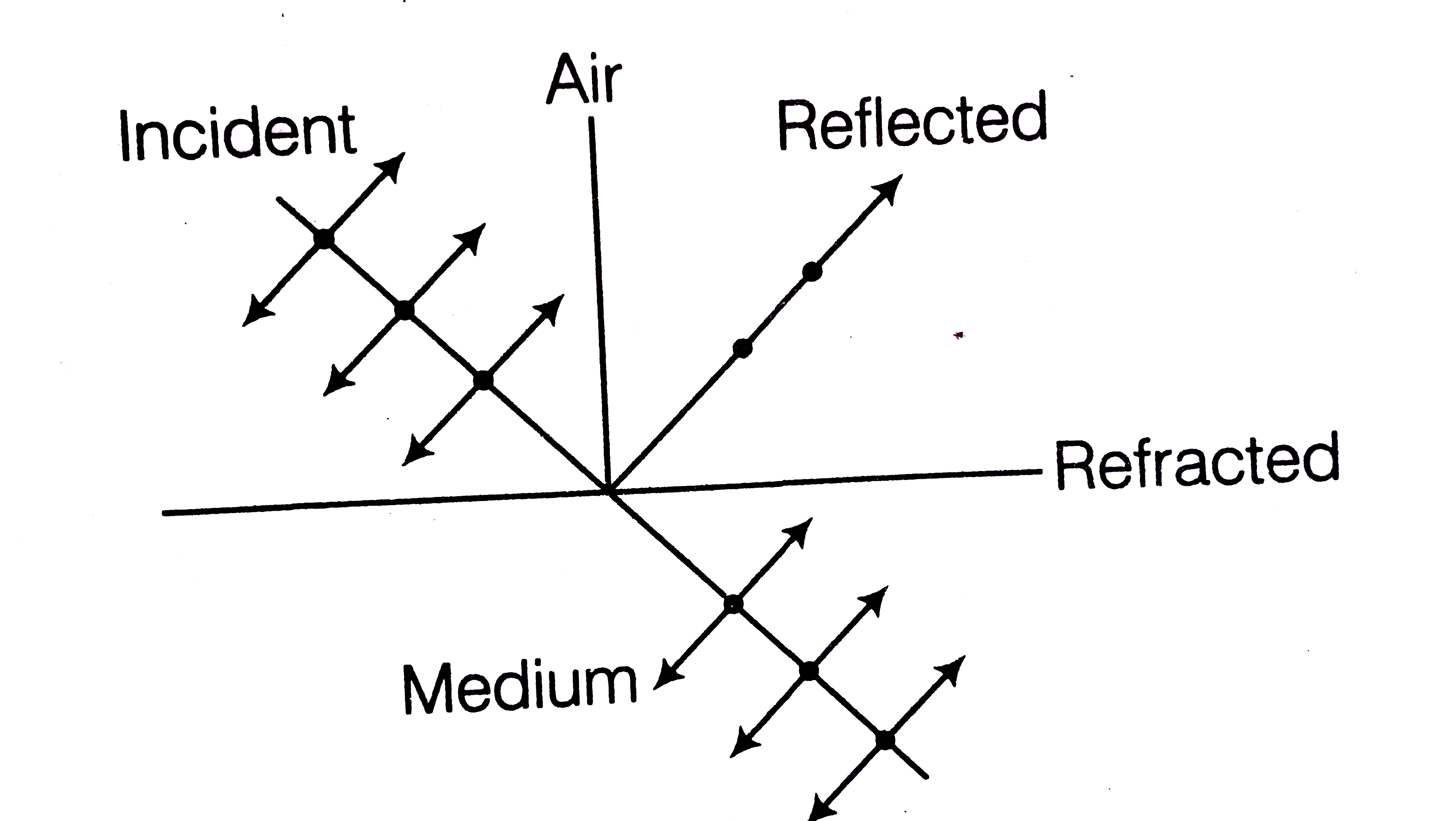Which of the following statement(s) is/are correct with reference to the figure given below?
I. Dots and arrows indicate that both polarisations are present in the incisent and refracted waves.
II. The reflected light is not linearly polarised.
III. Transmitted intensity will be zero when the axis of the analyser is in the plane of the figure i.e. the plane of incidence.

Only I
Only II
Both I and III
Both I and II
The correct Answer is:C
The oscillating electrons in the water produce the reflected wave. These move in the two directions transverse to the radiation from wave in the medium, i.e. the refracted wave. The arrows are parallel to the direction of the reflected wave. Motion in this direction does not contribute to the reflected wave.

Topper's Solved these Questions
- WAVE THEORY OF LIGHT Book:MHTCET PREVIOUS YEAR PAPERS AND PRACTICE PAPERSChapter:WAVE THEORY OF LIGHT Exercise:EXERCISE 2 (Miscellaneous Problems)
Explore 18 Videos
- WAVE THEORY OF LIGHT Book:MHTCET PREVIOUS YEAR PAPERS AND PRACTICE PAPERSChapter:WAVE THEORY OF LIGHT Exercise:MHT CET CORNER
Explore 4 Videos
- WAVE THEORY OF LIGHT Book:MHTCET PREVIOUS YEAR PAPERS AND PRACTICE PAPERSChapter:WAVE THEORY OF LIGHT Exercise:MHT CET CORNER
Explore 4 Videos
- WAVE MOTIONBook:MHTCET PREVIOUS YEAR PAPERS AND PRACTICE PAPERSChapter:WAVE MOTIONExercise:MHT CET CORNER
Explore 23 Videos
Similar Questions
When sunlight is incident on water at an angle of 53∘, the reflected light is found to be completely plane-polarised. Determine (i) angle of refraction of light and (ii) refractive index of water.
View SolutionWhich of the following statements is/are correct?
I) a polaroid of long chain molecules aligned in a particular direction
II) electric vectors along the direction of the aligned molecules in a polaroid gets absorbed
III) an unpolarised light wave is incident on polaroid, then it will get linearly polarized.
View Solution
Knowledge Check
Which of the following statement(s) is/are correct?
I. A polaroid consists of long chain molecules aligned in a particular direction.
II. Electric vectors along the direction of the aligned molecule in a polaroid gets absorbed.
III. An unpolarised light wave is incident on polaroid, then it will get linearly polarised.AOnly IBBoth II and IIICOnly IIIDAll of the aboveMonochromatic light of wavelength 589nm is incident from air on a water surface. Given, refractive index of water is 1.33.
Which of the following statement(s) is/are correct?
I. Frequency of reflected light and refracted light are same.
II. Wavelength of reflected light is more than that of refracted light.
III. Speed of reflected light is equal to that of refracted light.
IV. Intensity of reflected light is always more than that of refracted light.AI and IIIBII and IVCI and IIDIII and IVWhich of the following statement (s) is/are correct?
I. A point source emitting waves uniformly in all directions.
II. In spherical wave, the locus of point which have the same amplitude and vibrate in same phase are spheres.
III. At a small distance from the source, a small portion of sphere can be considered as plane wave.AOnly IBBoth I and IICOnly IIIDAll of these
A mixture of plane polarised and unpolarised light falls normally on a polarising sheet. On rotating the polarising sheet about the direction of the incident beam, the transmitted intensity varies by a factor 4. Find the ratio of the intensities IP and I0 respectively of the polarized and unpolarised components in the incident beam. Next the axis of polarising sheet is fixed at an angle of 45∘ with the direction when the transmitted intensity is maximum. Then obtain the total intensity of the transmitted beam in terms of I0.
[32,5I04]
View SolutionWhen light is polarised by reflection from a transparent surface.
a) reflection and refracted rays are mutually perpendicular
b) both reflected and refracted rays are plane polarised
c) refraction ray is partially polarised
d) the R.I., of transparent surface is equal to tangent of Brewster.s angle
View SolutionA wave incident obliquely on the boundary between two different media. Which of the following statements is/are incorrect?
I. The incident and the refracted waves obey Snell's law of refraction.
II. The incident and the reflected wave obey the usual laws of reflection.
III. The incident wave only gets reflected but not refracted.
Choose the correct option from those given below.
View SolutionWhich of the following statements are correct?
(i) The shape of a shadow depends on the position of the source of light.
(ii) A plane mirror can change the direction of light falling on it.
(iii) A pinhole camera forms an erect image of an object on a screen.
(iv) A shadow is formed when light passes through a transparent object .
View SolutionFor observing sustained interferencr with good contrast, which of the following option are correct?
(i) The sources must be coherent i.e. the phase difference must remain constant.
(ii) The frequencies, wavelengths and amplitudes of interfering waves must be equal and light must be monochromatic.
(iii) The source must be close to each other and must be narrow.
(iv) If the interfering beams are polarised, they must be in the same state of polarisation.
View Solution
